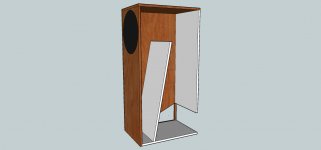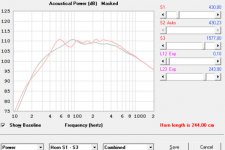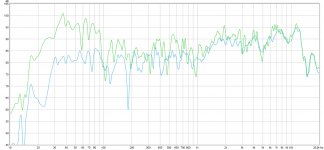I think by now, a refined BiB is possible. Mine are better, but still rough, but I am sure you could deliver a refined one, Scott. I enjoy using hornresp, but whatever software suits anyone should do.
I have picked up some ideas from Bernd Timmermans of the German magazine Hobby Hifi. His niche is finding accessible explanations and reliable ways to sim things, for hobbyists.
In case of an olson/nagaoka-style TL, he has repeatedly shown that it will sim like the TL below roughly 100Hz and like a sealed/ported enclosure above roughly 200Hz, with a transition gradient in between. The relation and transition is less straightforward with elaborate backloaded horns, but a BiB is more like that simple TL. So I use this to get a better feel for how a design will function in reality. I see room gain back in response measurements, very accurately, so I include this in my simulations.
So I get decent information about ripple over the pass band, extension, gain etc. I sim for no dips and don't mind excessive bass because I use EQ/DSP. Excessive bass saves amplifier power and frees up midrange even more. My measurements match my sims and assumptions pretty well.
My sort of final pipe horns (so far...) were intended as an Olson corner horn clone, but shifting the driver, changing expansion from exponential to parabolic and heavily damping the throat up to the driver improved response and make it into a pipe horn. If that's not refined...
I have picked up some ideas from Bernd Timmermans of the German magazine Hobby Hifi. His niche is finding accessible explanations and reliable ways to sim things, for hobbyists.
In case of an olson/nagaoka-style TL, he has repeatedly shown that it will sim like the TL below roughly 100Hz and like a sealed/ported enclosure above roughly 200Hz, with a transition gradient in between. The relation and transition is less straightforward with elaborate backloaded horns, but a BiB is more like that simple TL. So I use this to get a better feel for how a design will function in reality. I see room gain back in response measurements, very accurately, so I include this in my simulations.
So I get decent information about ripple over the pass band, extension, gain etc. I sim for no dips and don't mind excessive bass because I use EQ/DSP. Excessive bass saves amplifier power and frees up midrange even more. My measurements match my sims and assumptions pretty well.
My sort of final pipe horns (so far...) were intended as an Olson corner horn clone, but shifting the driver, changing expansion from exponential to parabolic and heavily damping the throat up to the driver improved response and make it into a pipe horn. If that's not refined...
Yes, I can design a refined (or relatively so) example. I've done enough of them over the years. 😉 But the point of the BIB, at least from my perspective, is that it's a simple tapped parabolic pipe-horn, and all the better for it. To get highly refined results from the BIB, or what I would describe as such, you would have to do a lot of empirical experimentation of prototypes in their intended room to optimise it to that space's acoustics, as the configuration means you have less flexibility / ways of working with the acoustic low pass, and you are even more reliant upon the boundary loading / interactions to assist with this. Frankly, I wouldn't want to. I like them the way they generally are. From your description, your own horns are pipe horns, but not what is usually described as a BIB, which is a simple tapped pipe horn with a single internal panel, and either an upward or downward firing terminus.
I can't really comment on Bernd's work as I do not subscribe to Hobby HiFi (I earn less than £450 per month so magazine subscriptions are not possible at present). However, a blanket statement that a horn using manifold expansion 'will sim like the TL below roughly 100Hz' is trickly to follow without some kind of context and clarification of how you are defining a 'TL.'
All pipes share some baseline physics if you go back far enough into generalarities, but assuming you mean resonant action, then that is entirely a question of terminus size relative to expansion length. Or to put it another way, what is the difference between the QW cutoff frequency (defined by length & expansion rate) and the lowest frequency to which the horn is impedance matched (defined by the terminus size). Vulcan for example, optimally loaded, is impedance matched down to its QW cutoff, give or take a few Hz, so it does not behave as a resonant pipe in the sense I think you are referring to. Smaller horns with less terminus area rely on increasing amounts of resonant action at lower frequencies; they're still horns since they have positive expansion so ultimately share some of the physics somewhere. Corner loaded, the BIB is usually impedance matched a bit lower than some realise, which is why in practice its output is often a bit cleaner than a 1/2 space or freespace simulation would imply.
Regarding the region above 200Hz that you mention, I assume you're referring to where the upper corner frequency is. That is one area manifold horns can have a significant advantage, as the folding, edges etc. can be designed in such a way as to be a functional part of the acoustic low-pass, as I do with my own.
I can't really comment on Bernd's work as I do not subscribe to Hobby HiFi (I earn less than £450 per month so magazine subscriptions are not possible at present). However, a blanket statement that a horn using manifold expansion 'will sim like the TL below roughly 100Hz' is trickly to follow without some kind of context and clarification of how you are defining a 'TL.'
All pipes share some baseline physics if you go back far enough into generalarities, but assuming you mean resonant action, then that is entirely a question of terminus size relative to expansion length. Or to put it another way, what is the difference between the QW cutoff frequency (defined by length & expansion rate) and the lowest frequency to which the horn is impedance matched (defined by the terminus size). Vulcan for example, optimally loaded, is impedance matched down to its QW cutoff, give or take a few Hz, so it does not behave as a resonant pipe in the sense I think you are referring to. Smaller horns with less terminus area rely on increasing amounts of resonant action at lower frequencies; they're still horns since they have positive expansion so ultimately share some of the physics somewhere. Corner loaded, the BIB is usually impedance matched a bit lower than some realise, which is why in practice its output is often a bit cleaner than a 1/2 space or freespace simulation would imply.
Regarding the region above 200Hz that you mention, I assume you're referring to where the upper corner frequency is. That is one area manifold horns can have a significant advantage, as the folding, edges etc. can be designed in such a way as to be a functional part of the acoustic low-pass, as I do with my own.
Last edited:
Here's my design. Clearly inspired by, but not quite a BiB.
The sim shows the Olson horn in red and my take in grey. The response of my hybrid thing evens out nicely with 12dB/octave room gain. Turned out that room gain was 18dB/octave but no worries. Just extra headroom in case of easy DSP.
The sim shows the Olson horn in red and my take in grey. The response of my hybrid thing evens out nicely with 12dB/octave room gain. Turned out that room gain was 18dB/octave but no worries. Just extra headroom in case of easy DSP.
Attachments
Definitely not a BIB as they're usually described, i.e. a tapped pipe horn with zero throat area for maximum gain BW, tuned to 1/2 wavelength of the target frequency. I can't see anything particularly 'hybrid' about the box you indicate though; it appears to be a conventional enough tapped pipe horn (aka Voigt pipe / horn, TQWT etc.)
I can't comment about the comparison since I've no idea what box you refer to as 'the Olson horn' was. Either way, you've clearly selected the option that works best for you in FR terms for the given acoustic space you have.
I can't comment about the comparison since I've no idea what box you refer to as 'the Olson horn' was. Either way, you've clearly selected the option that works best for you in FR terms for the given acoustic space you have.
Last edited:
retro vintage modern hi-fi: Harry Olson Folded Horn 1956
The project definitely started with my first BiB, a sense of freedom that good sound with some (a lot) of characteristics of horn bass was attainable with a big box with few panels. 😀
Then (after 3 more BiB designs) I wanted to recreate a classic work by a pioneer, and it had to fit in a corner, be backloaded (fullrange driver) and for a 15" drive unit. The woodworking was more than I thought I could handle, and applying some elementary lessons from simming BiBs yielded at least a similar result with less woodworking effort.
Net up is a version of the Voigt Home Constructors corner horn. Haven't quite figured out how to angle the curves in the side walls. I hear that's a common issue... ;-)
The project definitely started with my first BiB, a sense of freedom that good sound with some (a lot) of characteristics of horn bass was attainable with a big box with few panels. 😀
Then (after 3 more BiB designs) I wanted to recreate a classic work by a pioneer, and it had to fit in a corner, be backloaded (fullrange driver) and for a 15" drive unit. The woodworking was more than I thought I could handle, and applying some elementary lessons from simming BiBs yielded at least a similar result with less woodworking effort.
Net up is a version of the Voigt Home Constructors corner horn. Haven't quite figured out how to angle the curves in the side walls. I hear that's a common issue... ;-)
That it is. 😉 Getting angles right is usually a pain with designs of that type. Good luck!
Are you using the LC-1A? If you aren't, you weren't loading the Olson design as intended so the response may have more deviation. Although I can't quite tell if what you built was inspired by it rather than that box per se. BTW, the folded horn indicated in the build diagrams is not actually an example of manifold (sometimes called Olson / Nagaoka) construction, which is a separate approach used in some of Olson's Studio designs, and employs in at least part of the overall design an expanding cascade of individually untapered manifolds.
Are you using the LC-1A? If you aren't, you weren't loading the Olson design as intended so the response may have more deviation. Although I can't quite tell if what you built was inspired by it rather than that box per se. BTW, the folded horn indicated in the build diagrams is not actually an example of manifold (sometimes called Olson / Nagaoka) construction, which is a separate approach used in some of Olson's Studio designs, and employs in at least part of the overall design an expanding cascade of individually untapered manifolds.
That it is. 😉 Getting angles right is usually a pain with designs of that type. Good luck!
Are you using the LC-1A? If you aren't, you weren't loading the Olson design as intended so the response may have more deviation. Although I can't quite tell if what you built was inspired by it rather than that box per se. BTW, the folded horn indicated in the build diagrams is not actually an example of manifold (sometimes called Olson / Nagaoka) construction, which is a separate approach used in some of Olson's Studio designs, and employs in at least part of the overall design an expanding cascade of individually untapered manifolds.
I know it's not the classic manifold design. Someone mentioned it reaches low and does it well witha fullrange driver and it caught my attention. ;-)
I simmed with my Fane Souvereign 15-300TC. It matches certain traits of response measurements that were floating around the web at the time (made by whatshisname of the cast iron conical horns). GM also noted the driver sims well in other enclosure designs made for, or used successfully with, the RCA driver.
I started out with a basic whizzered 5 unit. Paper cone, PLASTIC whizzer. Still some of the most gripping sound I know. The whizzer is pretty soft, which must contribute to a pretty harmless sound. Xmax was rather large and qts was 0.5t was a pretty warm and dark driver to work with. Some EQ opened it up and it was versatile. After that came used Lowthers (what a diyaudio career) and they had impressive detail and midrange dynamics. So ever since the goal has been such detail and dynamics, but with the warmth and richness of.... Eh... Reality? So I reckoned, with the dynamics and bass handling of the 15" Fane, all I needed was a good horn with good reach to complete the mission.
I read "26 Hz", "dinosaur sound effects" and the rest is history. 😉
I was looking into Tannoy horns and saw this. Less known, fewer negative comments. In hindsight, a simmed R-GRF is not much better or worse, just different.
I read "26 Hz", "dinosaur sound effects" and the rest is history. 😉
I was looking into Tannoy horns and saw this. Less known, fewer negative comments. In hindsight, a simmed R-GRF is not much better or worse, just different.
Last edited:
BiB. The one that I have been thinking about since its appearance, but never got to do it. But maybe someday I will.
One question: If you wanted to do "bang for the buck" BiB, and you were to choose a 6 to 8" driver, which would you choose?
Hint: the one that will sound fine without Eq, no shout, something that would make you tap your feet...
One question: If you wanted to do "bang for the buck" BiB, and you were to choose a 6 to 8" driver, which would you choose?
Hint: the one that will sound fine without Eq, no shout, something that would make you tap your feet...
Oh blimey. That's a question. Can I get back when I've thought about it? 😀
*Edit, now that I've thought about it. Since it's been a while I've had to get my BIB mindset going. 😉
OK. For all the recent units that have come out, I'm going with two old favourites.
-Fostex FE168ESigma. Just about a 6in. It doesn't have the prettiest measurements, but most find it acceptable in practice. Goes in a reasonable sized pipe and produces goodly amounts of bass in the process.
-Fostex FE208ESigma. Although it was designed for use with a supertweeter, so you'd have to add. Preferably a good one. Slightly smoother than its smaller stablemate, needs a bigger pipe, obviously, but still more dynamic range / LF potential, assuming you have the space to accomodate it.
*Edit, now that I've thought about it. Since it's been a while I've had to get my BIB mindset going. 😉
OK. For all the recent units that have come out, I'm going with two old favourites.
-Fostex FE168ESigma. Just about a 6in. It doesn't have the prettiest measurements, but most find it acceptable in practice. Goes in a reasonable sized pipe and produces goodly amounts of bass in the process.
-Fostex FE208ESigma. Although it was designed for use with a supertweeter, so you'd have to add. Preferably a good one. Slightly smoother than its smaller stablemate, needs a bigger pipe, obviously, but still more dynamic range / LF potential, assuming you have the space to accomodate it.
Last edited:
I heard the FE168ESigma in a design in progress (no damping, no measurements, work to do), stunning midrange.
Here's my design.
I designed and drew 1 BIB as a B-Day present to myself, it had tweaks intended to also smooth the bottom. The iBIB. If neede di can dig up the URL to the draing if anyone wants some inspiration.
dave
Harry Olson Folded Horn 1956
Not the Olsen Horn that comes to mind. The one that was a precursor to the Nagaoka style horns and many of Scott’s.
dave
I heard the FE168ESigma in a design in progress (no damping, no measurements, work to do), stunning midrange.
Not as good as the FE108e∑ in that respect.
dave
True. The 108 was always one of the best units of its size in that sense. Doesn't have the LF capacity of the larger drivers though.
...and you were to choose a 6 to 8" driver, which would you choose?
Depends on the drivers. I tend to prefer smaller drivers.
dave
But in Aiko or Lancet can produce more bass than most would imagine.
Very true. 😉
- Home
- Loudspeakers
- Full Range
- BIB vs Tapered Transmission Line


